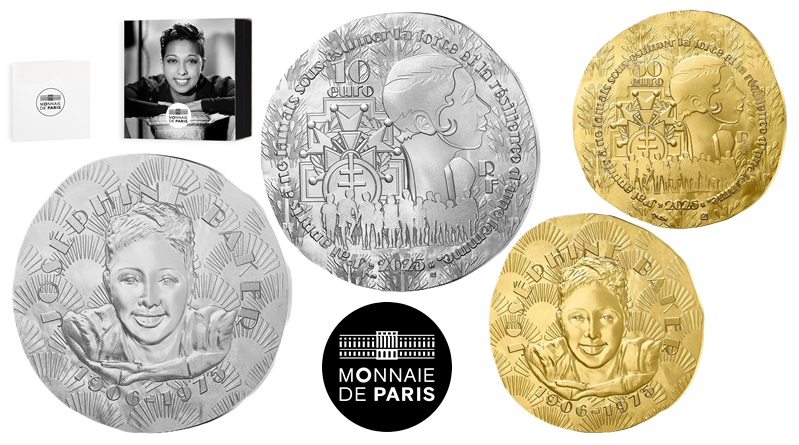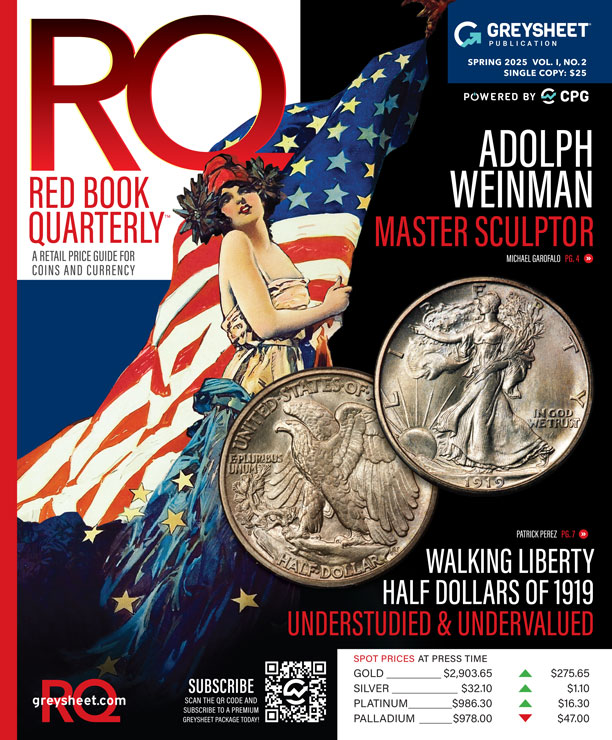France Iconic American-Born Entertainer Features on New Gold and Silver Free-Style Strike Coins
The Monnaie de Paris release collector silver coins featuring a legendary entertainer of the roaring 20’s.
The Women of the World series features Josephine Baker who is the second American-born woman featured after Grace Kelly in 2022. Josephine Baker is one of the most influential entertainment and advocate figures of the 20th century, and in 2025 the coins commemorate the 50th anniversary of her death. She was a woman of bi-racial American heritage who found fame in France as a dancer, singer, actress and resistance fighter during the Second World War. First known for her dance performances in the United States, she moved to Paris one hundred years ago where she became a true icon of the Roaring Twenties.
Born Freda Josephine MacDonald on the 3rd June 1906, to her mother Carrie and an unknown father believed to be of German origin. She grew up in an impoverished neighbourhood in St Louis Missouri where she left school by the age of twelve and took up employment as a waitress in a local drinking establishment. Married by the age of thirteen, and lasting only a year, she took up street performing with a dance troupe but would marry for the second time two years later in 1921 to William Howard Baker. Josephine left him when her vaudeville troupe was booked into a venue in New York City. They divorced in 1925 when her career success was beginning and so she continued to use his last name professionally for the rest of her life. During her time in New York City, she auditioned for dance parts and managed to secure a role in the chorus line of a touring production of the ground-breaking and hugely successful Broadway revue ‘Shuffle Along’. This led to a string of more successful parts in dance revues which lasted until November 1924. It was at this time when Josephine made the decision to sail for Paris where the nineteen-year old American dancer would find a starring part in ‘la Revue nègre’ at the Théâtre des Champs-Élysées in October 1925. Within a very short time, Josephine became the undisputed queen of the Roaring Twenties in Paris, where she shone on the stage of many of the exclusive clubs and theatres. Her influence as a Black artist in 1920’s Europe fascinated by exoticism made her an icon of freedom of expression. Embracing the language and culture of her newly adopted country, she relinquished her US nationality and became a French citizen in 1937. Because of this decision and her hugely successful song entitled ‘J'ai deux amours’ released in 1931, the sentiment and lyrics that I have two loves, my country and Paris, endeared her to France and the French people for the rest of her life.
In September 1939, at the start of the Second World War, Josephine was recruited by the French military intelligence agency, as an undercover ‘honourable correspondent’. Because of celebrity status in the country and further afield, she was still able to travel and socialise with the German occupiers at embassies, ministries and night clubs while secretly gathering useful information. Baker was able to gather information covertly without raising suspicion and did so until the end of the War in 1945 while at the same time entertaining British, French and American soldiers in North Africa. For her heroic efforts, she was awarded the Resistance Medal by the French Committee of National Liberation, the Croix de Guerre by the French military and was named a Chevalier of the Légion d'honneur - the highest and most prestigious French order of merit by General Charles de Gaulle.
After the war, and with her fourth husband composer and conductor Joseph Bouillon whom she married in 1947, she embarked on a mission to adopt boys and girls from many backgrounds, religions and ethnicities which she often referred to as "The Rainbow Tribe". In 1951, she travelled to her homeland but was often subjected to segregation policies, so Baker made only intermittent visits to the US. Her last visit was in 1973 for her performance at Carnegie Hall where she received a standing ovation.
After her divorce from Bouillon in 1961, she continued to live with her children in a property known as Château des Milandes, a castle near Sarlat in Southwestern France. Due to less frequent work and a large family to look after, her finances were soon depleted and by 1968, she was forced to leave her home. Her long-time friend Grace Kelly, now the Princess Consort of Monaco offered her and the children use of a large apartment just outside the principality. She made occasional appearances and performances in Paris in 1968, her triumphant engagement at Carnegie Hall in 1973, at the Royal Variety Performance at the London Palladium as well as singing at the Gala du Cirque in Paris in 1974.
On April 8, 1975, Baker starred in what would ultimately be her last retrospective revue in Paris entitled Joséphine à Bobino 1975 celebrating her 50 years in show business. The production was financed by friends Prince Rainier and Princess Grace of Monaco and Jacqueline Kennedy Onassis which opened to rave reviews. Demand for seating was such that fold-out chairs had to be added to accommodate spectators. The opening-night audience included celebrities Sophia Loren, Mick Jagger, Shirley Bassey, Diana Ross and Liza Minnelli. Just four days after her opening, Baker was found in a coma lying peacefully in her bed surrounded by newspapers with glowing reviews of her performance, having suffered a cerebral haemorrhage. She was taken to Hospital where she died aged 68 on the 12th April 1975.
As Josephine had converted to Catholsicm, she received the rites of a Catholic funeral at the L'Église de la Madeleine Church in Paris where her funeral attracted more than 20,000 mourners. Baker is the only American-born woman who received full French military honours at her funeral which was staged with a huge procession. After a family service at Saint-Charles Church in Monte Carlo, Baker was interred at the Cimetière de Monaco. On the 30th November 2021, Baker was inducted into the Panthéon in Paris, she is the first black woman to receive one of the highest honours in France. As her resting place remains in the Monaco Cemetery, a cenotaph was installed in vault 13 of the crypt in the Panthéon. In 2024, a profile of Josephine Baker was depicted on France’s 20 euro-cent circulation coins in tribute to outstanding female personalities of France.

The collector coins in the Women of the World series are characterised by a free striking style. These coins have an irregular relief and diameter, due to how the metal is struck and without a collar to define an exact diameter. The collection includes two separate collector coins of gold and silver which is designed by senior engraver Joaquin Jimenez. The obverse side features a front-facing portrait of the singer, which is based on a publicity photograph of her at the height of her career. The background is that of a typical 1920’s Art Deco style. Above and along the upper rim is the text JOSEPHINE BAKER and below her image are the years 1906 – 1975. The reverse side includes many references to Baker’s life, with images of the medal of the Croix de Guerre, the medal of the Legion of Honour and the Cross of Lorraine of the commemorative medal of voluntary services in Free France. To the right of the medals, a reminder of her past as a singer and dancer and star of the Roaring Twenties with a profile of Josephine Baker in stage dress. Below these two references, a silhouette of her eleven children, the famous Rainbow Tribe. Surrounding the composite design is the commemorative inscription J’ai appris à ne jamais sous-estimer la force et la résilience d’une femme (I have learned never to underestimate a woman's strength and resilience). Above the medal of the Croix de Guerre is the coins’ denomination of 50 euro (gold) or 10 euro (silver) and the letters RF representing Republique Francaise are seen just to the right of the Baker’profile. The year of release 2025 is placed below the primary design along with the mintmark of the Monnaie de Paris and insignia of the engraver.
| Denomination | Metal | Weight | Diameter | Quality | Maximum Mintage |
| *10 Euro | .333 Silver | 18 g. | 33 mm. | BU | 10,000 |
| 10 Euro | .900 Silver | 22.2 g. | 37 mm. | BU | 3000 |
| *100 Euro | .900 Silver | 45 g. | 47 mm. | BU | 3000 |
| 50 Euro | .999 Gold | 7.78 g. | 22 mm. | BU | 500 |
Available from the 16th March, the free-style strike gold and silver coins are specially encapsulated and presented in a custom Monnaie de Paris case accompanied with a certificate of authenticity. *The €10 and €100 editions are struck in BU as standard coins with a smooth edge and presented in a blister-pak card (€10) and encapsulated enclosed in a custom presentation folder (€100). For additional information, please visit the online webshop of the Monnaie de Paris.

Download the Greysheet app for access to pricing, news, events and your subscriptions.
Subscribe Now.

Subscribe to RQ Red Book Quarterly for the industry's most respected pricing and to read more articles just like this.
Author: Michael Alexander
Related Stories (powered by Greysheet News)
View all news
The German Ministry of Finance and Munze Deutschland launch their collection of gold coins for 2025.

A very limited number of medals containing one ounce of pure Welsh gold will soon be auctioned.

The Royal Dutch Mint release their first Silver Proof Ducat for 2025 as part of a popular collector series.









Please sign in or register to leave a comment.
Your identity will be restricted to first name/last initial, or a user ID you create.
Comment
Comments